The Glow of Paris: The Bridges of
Paris at Night
Dr. Jessie Voigts interviews Gary
Zuercher about his new photography book, "The
Glow of Paris: The Bridges of Paris at Night."
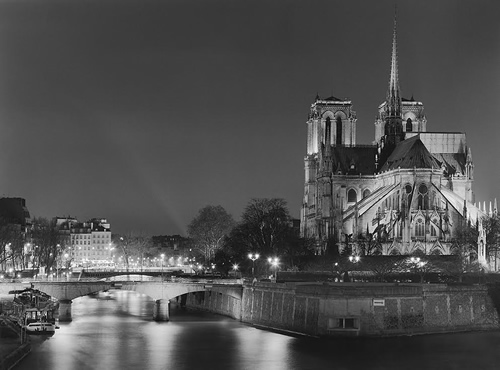
|
|
Pont de l'Archevêché. The
name Archevêché means the diocese of the
archbishop. The bridge connects the left bank of the
river with Notre Dame on the island named Île de la
Cité. Photo © Gary Zuercher.
|
The many moods of Paris — we’ve
seen some of them, while others hide away from us, and slowly
unfurl (if we’re lucky). However, one thing about Paris
strikes awe — that of Paris in the evening. In the summer,
the streets are alive, with people celebrating, heading
home, heading out, and taking the air with their dogs. In
the fall, the crisp air makes the bright lights stand out.
But in the winter? Oh, those lights do glow. And until I
read The Glow of Paris: The Bridges of Paris at Night,
I had no idea just how much.
The Glow of Paris is an extraordinarily
beautiful book of photographs that reveals a new side to
Paris — one that, I imagine, few of us have ever seen. It’s
lovely to see Paris in a new light, so to speak. The book,
written and photographed by Gary Zuercher, is the best book
photography book I’ve ever seen. But it’s so much more
than that. This book combines history, geography, architecture,
engineering, and art. It teaches us to look at Paris with
new eyes, and instills in us an appreciation for these bridges
— ordinary structures during the day, that allow the movement
of people, cars, bikes, boats.
We learn of the history of each bridge,
stories, details, insider information. And then, oh then,
we see. We see a strange Paris, with no people or cars.
The streets are empty, and Paris starts to reveal herself.
Each bridge is a work of art. We forget that, when we hurry
and scurry. Each bridge is packed with history, meaning,
artisanship, and is, always, something to cross the Seine.
That purpose shines clear here, as do the dreams that
we all carry of Paris. This book? Paris — a Paris we didn’t
know existed — comes alive.
We were lucky enough to catch up with
Gary Zuercher, to ask him about his many years of photographing
Paris, inspiration, and more. Here’s what he had to say…
Q: Please tell us about your
book, The Glow of Paris...
GZ: The Glow of
Paris gives you a graphic account of the history
of the 35 bridges that cross the Seine in Paris. It’s
a history book that commences with Julius Caesar and
proceeds up through the death of Princess Diana, and
continues to the current day. But more than that, it
includes 84 stunning, large format black and white photographs
that show us the luminosity of the bridges at night and
takes our breath away. By day the bridges, while rather
utilitarian, are nevertheless attractive, but at night
they take on a luminescence that can’t be seen in the
daylight. They glow.
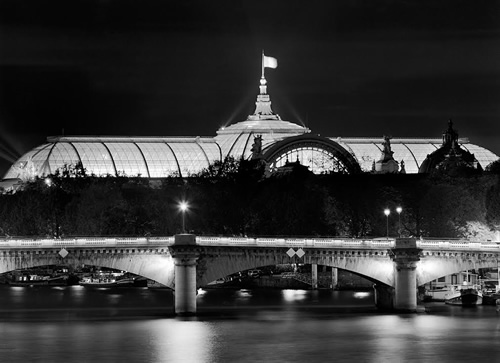
|
|
Pont de la Concorde.
Links the Place de la Concorde at the foot of the
Avenue des Champs-Élysées with the Assemblée nationale
that forms the Senat and the Parliament of France.
Here seen with the majestic Grand Palais in the background.
Photo © Gary Zuercher.
|
Q: What inspired you to create
this amazing book?
GZ: The inspiration
came as the result of a mistake. My wife and I live part
time in Paris and part time in the U.S. One night while
shooting in Paris, I took a photograph of one of the bridges.
The photographs are taken on film and in black and white.
As soon as I took the photo, I realized I had miscalculated
and had greatly overexposed the shot. The only thing I could
do was to under develop the negative in the hope of salvaging
something from the shot. The negative that resulted produced
a photograph that just took my breath away. Because of that
negative I decided to photograph all thirty-five of the
bridges that cross the Seine in Paris, using that same concept
of overexposure coupled with under development to get similar
results. Although the book was not then yet on the radar,
it was a natural next step once the project was complete.
Q: How long did it take to take
the photos and do all of the research? What were the
challenges?
GZ: It took much longer
than I expected. In the beginning, I expected it would take
at least a year to complete. In the final analysis, it took
five years for the photography and one more year for the
research into the history of the bridges. The first obstacle
was daylight. In the summer, it is daylight in Paris up
to about 11 p.m., and the lights are turned out on the bridges
at midnight, so that leaves too short a period to obtain
good productivity. In the winter however, darkness comes
at five o’clock and there is plenty of time to shoot. One
other problem is that I was spending less than half the
time in Paris, so naturally I could only shoot while I was
there.
As for challenges there were plenty.
Challenges posed by weather, and temperature; and challenges
of carrying gear around, being alone by the river at night,
and finding parking for the car; at night everything is
different. But probably the biggest challenge was getting
just the right shot. There were times that I thought I had
taken a terrific shot only to find, when the negative was
developed, that in reality it wasn’t so good. Sometimes
the same shot was taken over and over, just to get it right.
I went back to shoot at some bridges time after time before
a perfect shot was finally obtained.
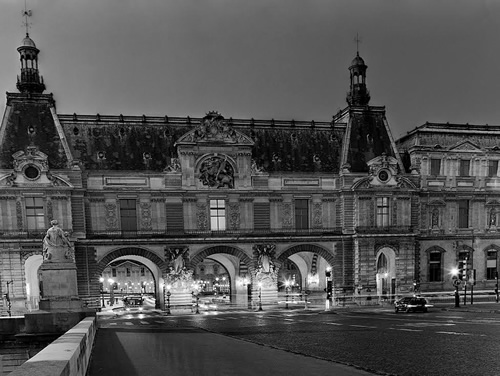
|
|
Pont du Carrousel.
This bridge links the left bank of the Seine to one
of the most attractive entrances to the Louvre. This
view seen while crossing the pont is of the entrance
named the guichet du Louvre and enters into
the carrousel of the Louvre. Photo © Gary Zuercher.
|
Q: What is your favorite bridge — and
why?
GZ: That’s not an easy
question. I have many favorite bridges, but probably the
two favorites are Passerelles. A Passerelle is
a footbridge. The two are the Pont des Arts and Passerelle
Simone de Beauvoir. The Passerelle Simone de Beauvoir was
built in 2006 and remains the newest of the bridges. It
is a modern design with an undulating structure that serves
three levels on each side of the river. It is the only bridge
that is named for a woman. You can walk or ride a bike across
it. It is a beautiful, flowing design that exhibits grace
and beauty, modern in design and utilitarian in use. The
second and perhaps even more beautiful is the Pont des Arts.
This footbridge is built ten steps above the adjacent roadways
on each side. Its elevation above each side makes it stand
out from the surroundings. It gives you the sense of standing
on a balcony with a breathtaking view both upstream and
downstream. On one side of the river you have the Louvre
downstream, and the La Samaritaine department store upstream,
on the other side is the Institut de France and upstream
is the bridge named Pont Neuf, that crosses the Île de la
Cité at the park named Vert Galant. The Pont des Arts provides
a very picturesque view and is picturesque itself.
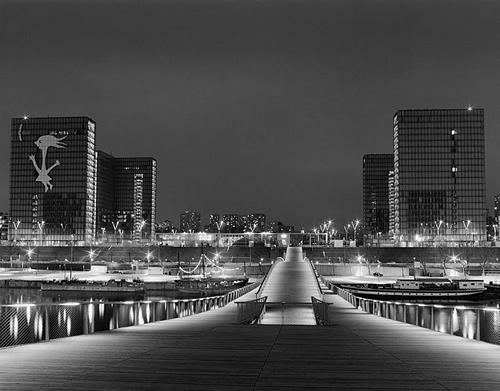
|
|
Passerelle Simone de
Beauvoir. This is a footbridge and is
the newest bridge crossing the Seine in Paris.
It opened in 2006. It is the only Paris bridge
named in honor of a woman. Photo © Gary Zuercher.
|
The one problem with the Pont des Arts,
as well as with some of the other bridges, is the lovelocks
that are now attached to it. A couple writes their name
on a lock, locks it onto the guardrail fence, and then they
throw the key into the river as a symbol of their undying
love. The bridge has become absolutely inundated with locks;
at the last counting there were more than 400,000 locks
on the Pont des Arts alone, weighing more than 200,000 pounds.
This poses the problem of not only the weight but the ugliness
of the locks. A solution will probably be found some day,
but in the meantime the locks detract from the beauty of
the bridge.
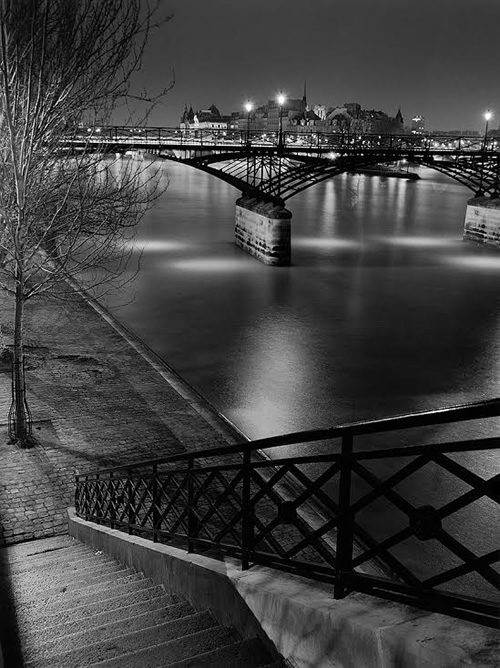
|
|
The Pont des Arts is
a Passerelle (footbridge) considered by many
to be the most romantic spot in Paris. It was built
by Napoleon Bonaparte in the early 1800s. Photo © Gary
Zuercher.
|
Q: What do you see are the main
differences in Parisian bridges from walking to all purpose
bridges, in terms of design and beauty?
GZ: The 35 bridges
that cross the Seine cover a span of history from 1607 when
the Pont Neuf was inaugurated to the inauguration of the
Passerelle Simone de Beauvoir in 2006. They cover a period
of 400 years. Very few places can brag of thirty-five consecutive
bridges that cover this amount of history. There are concrete
bridges, masonry bridges, iron bridges, and steel bridges.
The design of the bridges varies from that of the Pont Neuf
, which is actually many small bridges linked together to
form a single bridge, to the Passerelle Léopold Sédar-Senghor,
which is a single span bridge with no support structure
in the water. The bridges of Paris not only cover a long
and important span of history, but also an extremely varied
method of design and construction.
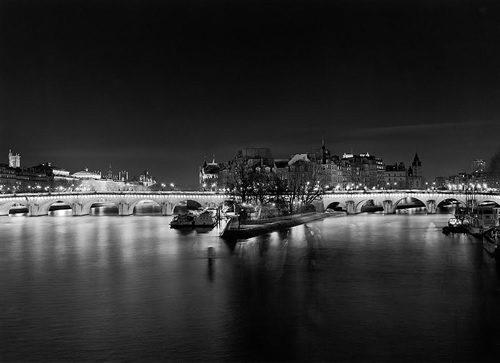
|
|
The Pont Neuf is
the oldest bridge in Paris. It was inaugurated in
1607 by King Henri IV. The word Neuf in French
means new in English thus the oldest bridge is named
the new bridge. It spans the downstream tip of the
Île de la Cité and connects the island to both the
left and right banks of the Seine. Photo © Gary
Zuercher.
|
Q: What’s up for you next?
GZ: A new project
is unfolding now, that is the shooting of some of the most
interesting bridges of Europe. There are many different
eras, designs, and types of bridges in Europe; I hope to
be able to capture some of them. In this respect, I have
recently begun shooting in Barcelona, Spain and am scheduled
to shoot in Seville, Spain. There I will shoot some of the
ultra-modern bridges designed by the well-known bridge designer
Santiago Calatrava. And then, on to shoot some of the well
known bridges in France, Netherlands, Sweden, and Germany,
as well as in other countries. It is an ambitious project
that will take some time to complete.
|
For More Information
You can purchase Gary Zuercher's book on his
website, with some photos, maps,
and a video about the bridges of Paris.
Marcorp Editions — U.S.-based
distributor site where the book may be purchased
in English or French.
Photos furnished for publication
by Diario Las Americas, courtesy and Copyright
Gary Zuercher.
|
Dr.
Jessie Voigts is the publisher of Wandering
Educators, a travel library for people curious
about the world. She’s published
six books about travel and intercultural learning,
with more on the way. You can usually find her family
by water — anywhere in the world.
|
